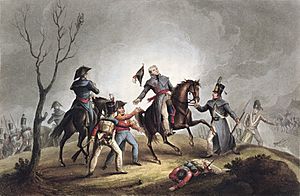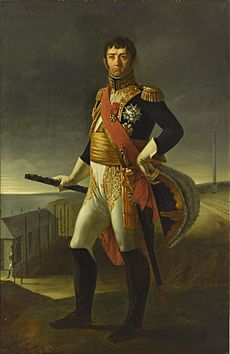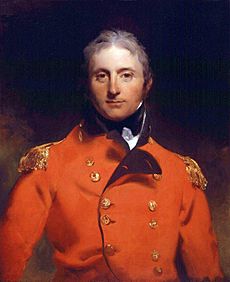Battle of Corunna facts for kids
Quick facts for kids Battle of Corunna |
|||||||
|---|---|---|---|---|---|---|---|
| Part of the Peninsular War | |||||||
 Death of Sir John Moore at the Battle of Corunna, derived from an engraving by Thomas Sutherland and aquatint by William Heath |
|||||||
|
|||||||
| Belligerents | |||||||
| Commanders and leaders | |||||||
| Strength | |||||||
| 16,000: 15,000 infantry 9 to 12 guns |
16,000: 12,000 infantry 3,200 cavalry 20 guns |
||||||
| Casualties and losses | |||||||
| 900 dead or wounded 300 sick abandoned 300 missing 6 transports lost 8 Spanish ships of the line 3 frigates and "numerous" corvettes abandoned 2 Spanish regiments captured Heavy material losses 5,000-6,000 sick |
600 to 700 dead or wounded 200 to 300 prisoners |
||||||
The Battle of Corunna was a major fight that happened on January 16, 1809, in Corunna, Spain. It was part of the Peninsular War, which was itself a bigger conflict within the Napoleonic Wars. In this battle, a British army led by Sir John Moore was attacked by a French army under Jean-de-Dieu Soult.
The British army had been forced to retreat across northern Spain after Napoleon's forces defeated the Spanish armies. Sir John Moore had tried to attack the French to distract them, but his army then had to make a long, difficult retreat to the coast.
During their retreat, the British soldiers faced harsh winter conditions. They were constantly chased by the French. When they finally reached the port of Corunna, their ships weren't there yet. After a few days, the ships arrived, and the British began to leave. But the French attacked, forcing another battle before the British could escape.
The British managed to hold off the French attacks until nightfall. They then continued to board their ships throughout the night. The last ships left in the morning, even under French cannon fire. Although the British escaped, the French took control of Corunna, Ferrol, and northern Spain. Sadly, Sir John Moore was badly wounded during the battle and died after learning his troops had successfully fought off the French.
Contents
Why the Battle Happened
The Battle of Corunna was the end of a long journey for the British army. It started with the Corunna campaign.
Setting the Scene: Armies in Spain
In late 1808, Sir John Moore took charge of the British army in Portugal. He had about 30,000 soldiers. More British troops, about 12,000 to 13,000 men, arrived in Corunna on October 13. Moore's orders were to help the Spanish fight against Napoleon's invading French forces.
Napoleon was worried about the situation in Spain. The French had lost a battle at Bailén, and Portugal was no longer under their control. Napoleon decided he needed to go to Spain himself to fix things.
By October, the French had about 75,000 soldiers in Spain. They faced 86,000 Spanish troops, plus 35,000 British allies who were on their way. However, the Spanish forces were not well organized. Their local governments, called juntas, often argued and made it hard for the army to work together.
While the allies moved slowly, Napoleon brought a huge army of 100,000 experienced soldiers into Spain. He told the Spanish leaders:
I am here with the soldiers who conquered at Austerlitz, at Jena, at Eylau. Who can withstand them? Certainly not your wretched Spanish troops who do not know how to fight. I shall conquer Spain in two months and acquire the rights of a conqueror.
Starting in October 1808, Napoleon led a strong attack. He quickly defeated the Spanish armies.
The British army was spread out, which was dangerous. Moore was in Salamanca, while other parts of his army were far away. Moore learned that the Spanish forces had been badly beaten. To avoid disaster, he decided to retreat back to Portugal.
Before retreating, Moore found out that French General Jean-de-Dieu Soult's army of 16,000 men was spread out and didn't know where the British were. On December 15, Moore saw a chance to attack the French near Madrid. He hoped to defeat Soult and make Napoleon change his plans. Moore's army grew to 23,500 infantry and 2,400 cavalry. On December 21, they successfully attacked French soldiers at Sahagún. But Moore didn't follow up on this success, allowing Soult to gather his forces.
The Retreat to Corunna
A Difficult Journey to the Coast

Once Moore's army was discovered, Napoleon quickly reacted. He wanted to destroy the British army. Moore realized he was in danger of being trapped, so he ordered a fast retreat. This long chase covered over 250 miles. The British cavalry and Light Brigade helped protect Moore's army as they retreated, fighting small battles with the French. They even defeated a French cavalry force at Benavente.
The British retreat was incredibly tough. They marched through mountains in terrible cold and snow. Soldiers were exhausted and suffered greatly. Many British soldiers lost discipline, especially after drinking too much wine. Hundreds were left behind and captured by the French.
Moore tried to make a stand at Lugo on January 6, offering to fight Soult. But Soult's forces were too spread out at first. By the time Soult was ready, Moore had slipped away during the night. He had to destroy artillery and food and shoot 500 horses that couldn't go on.
Moore realized he couldn't reach the port of Vigo. He ordered the transport ships to come to Betanzos Bay, near Corunna. He then headed for Corunna. Rainstorms and confusion caused the British army to break up, with thousands of soldiers falling behind. French cavalry captured many of these stragglers.
Finally, on January 11, the main British army reached the port of Corunna. They hoped to find ships to take them back to England. But the bay was empty, with only a few ships at Corunna itself. The rest of the 245 ships had been delayed by bad winds. They didn't arrive until January 14.
The French army also suffered during their pursuit. Their soldiers were tired and hungry. Soult's infantry divisions arrived in Corunna over the next few days, one by one.
Preparing for Battle at Corunna
When the British arrived in Corunna, they found many supplies. They received 5,000 new muskets and plenty of ammunition, food, and shoes. They also found Spanish cannons.
The French army started arriving the next day, getting stronger as more troops came in. Soult's heavy cannons arrived on January 14. That evening, the long-awaited British transport ships finally arrived. The British quickly loaded their sick, some horses, and most of their cannons and cavalrymen. The British had no plans to stay and defend Corunna. They destroyed huge amounts of military supplies, including powder and cartridges, so the French couldn't use them.
The British had about 15,000 infantry soldiers, while the French had 12,000 infantry. The rough ground around Corunna meant that Soult's cavalry would not be very useful. The British soldiers were now well-rested and well-fed, unlike the tired French.
Moore placed his army on a ridge about a mile and a half south of the harbor to protect the evacuation. He put his main force there. A stronger position was further south, but Moore felt he didn't have enough men to defend it. He placed small groups of soldiers there to slow down the French. The left side of the British line was protected by a river. The right side was more open and could be attacked by French cannons. Moore kept two divisions ready as a reserve to protect his right side.
On January 15, French troops pushed back the British outposts and set up their heavy cannons on the high ground. These cannons could fire down on the British right flank. It was a difficult task, and it took all night to get the cannons into position.
The Battle Begins
On the morning of January 16, both armies watched each other across the valley. Moore planned to continue loading his troops onto ships later that day if the French didn't attack. But at 2:00 pm, he learned the French were attacking.
Soult's plan was to attack the strong British left and center to keep them busy. Meanwhile, his infantry division would attack the weaker British right side, near the village of Elviña. If this attack worked, the French could cut off the British army from Corunna.
The French infantry quickly advanced, pushing back the British outposts. They took the village of Elviña and attacked the hills beyond it. The French columns split, attacking the British from the front and side. French cavalry tried to move around the British left, but the rough ground made it hard.
The fiercest fighting happened in and around Elviña. The village changed hands several times. The British suffered a lot from the heavy French cannons on the opposite heights. As the French broke through Elviña, Moore sent in the 50th Foot and the 42nd (Black Watch) to stop them. Moore stayed in this area, directing the battle. He ordered more troops to fire on the French and called up his reserve.
The British pushed past the village, but some confusion allowed the French to drive them back through Elviña again. Moore called up more reserves, about 800 men from the Guards. Together with the 42nd, they stopped the French advance.
Moore had just rallied his troops when he was hit by a cannonball. He was mortally wounded in the shoulder. He remained conscious for hours, even as he was dying. The British pushed the French back through Elviña a second time. The fighting continued, with both sides sending in more troops. Eventually, the French retired as night fell.
For a time, the British were without a clear leader because Moore was dying and Sir David Baird was also seriously wounded. General John Hope took command.
Further west, the French cavalry tried to attack the British flank, but the rough ground made it difficult. They were eventually pushed back by British riflemen and other troops. French cavalry also tried to cut off the British at the gates of Corunna, but the terrain and British defenses stopped them.
Night brought an end to the fighting. The French attacks had been stopped, and both armies held roughly the same ground as before the battle.
Aftermath of the Battle
The guerilla war continued until the end of the Peninsular War. The Spanish conventional warfare continued until the end of the Peninsular War. The British intervention continued until the end of the Peninsular War.
Napoleon had ended his invasion of Spain with the occupation of Madrid. The Corunna campaign ended with the British army leaving Spain. The Spanish campaign in early 1809 started with the Battle of Uclés.
British Escape and French Gains
General Hope, now in command of the British army, decided to continue loading the ships instead of fighting more. Around 9:00 pm, the British quietly began to leave their positions. They left behind small groups of soldiers to keep watch-fires burning, making it seem like they were still there.
At dawn on January 17, these last soldiers boarded the ships. By morning, most of the army had left. When Soult realized the British were gone, he placed cannons on the heights above the bay. By midday, the French could fire on the ships. This caused some panic, and four transport ships ran aground. They were then burned to prevent the French from capturing them. British warships fired back and silenced the French cannons.
On January 18, the last British soldiers left. The Spanish soldiers defending the city, led by General Alcedo, held out until the British fleet was safely at sea before surrendering. The French took control of Corunna. They captured two Spanish regiments, 500 horses, and many military supplies, including cannons, muskets, and gunpowder. A week later, Soult's forces captured Ferrol, an even bigger naval base. They took eight large warships, three frigates, and many smaller ships, plus a huge amount of military equipment.
The British lost about 900 men killed or wounded in the battle. They couldn't take all their horses on the ships, so they had to kill nearly 2,000 cavalry horses and about 4,000 more horses from the artillery and supply wagons to prevent them from falling into French hands. The French lost about 1,000 men killed, wounded, or captured. The most important loss for the British was Sir John Moore, who died after the battle. Sir David Baird, Moore's second-in-command, was also badly wounded.
On the morning of the battle, over 4,000 British soldiers were sick. A few hundred were too sick to leave and were left behind. Two more transport ships were lost with about 300 troops. When the army returned to England four days later, about 6,000 soldiers were ill.
Within ten days, the French had captured two fortresses with huge amounts of military supplies. These supplies helped Soult's army get ready for their next moves. However, Spanish fighters and local militias soon began to fight back against the French in Galicia, eventually driving them out of the province in June 1809.
See also
 In Spanish: Batalla de Elviña para niños
In Spanish: Batalla de Elviña para niños





